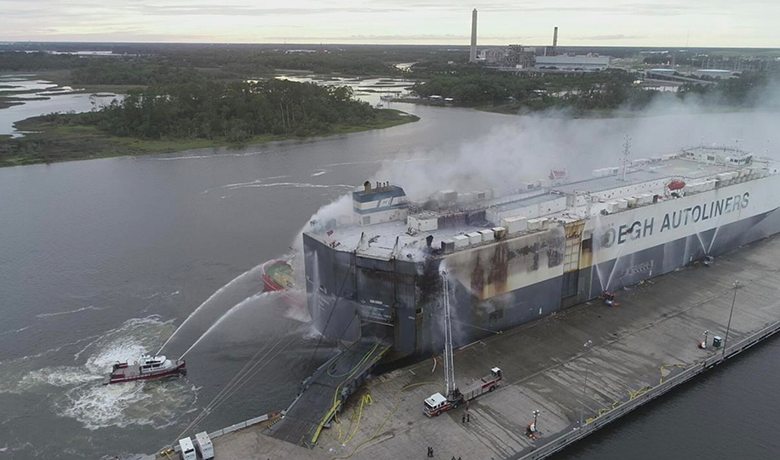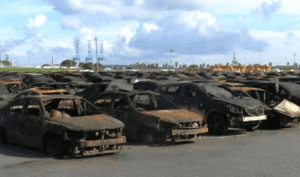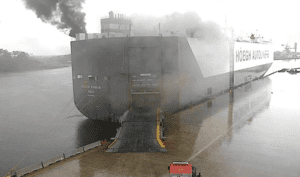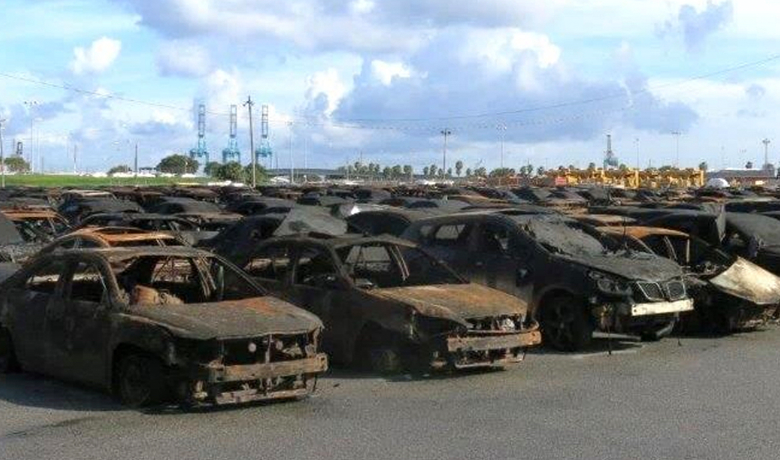

The fire aboard Hoegh Xiamen started on June 4, 2020, at about 1530 while it was docked at the Horizon Terminal ro-ro facility. The fire burned for eight days, destroying its cargo of more than 2,400 used vehicles worth about $40 million. The ship has since been scrapped. Nine Jacksonville firefighters were hurt fighting the fire, five seriously.
The National Transportation Safety Board (NTSB) determined the fire started on deck 8, which contained vehicles loaded in Jacksonville. It then spread to other levels. Investigators attributed the fire to an electrical arc or component fault from a battery.

Hoegh Technical Management Inc. operated Hoegh Xiamen, which was on charter to Grimaldi Deep Sea at the time of the fire. Grimaldi contracted with SSA Atlantic to facilitate vehicle loading, a task it hired the International Longshoreman’s Association (ILA) to help with.
Grimaldi and SSA Atlantic’s ineffective oversight of battery disconnection procedures was the leading cause of the fire, the NTSB determined.
“Contributing to the delay in the detection of the fire was the crew not immediately reactivating the vessel’s fire detection system after the completion of loading,” the NTSB report continued. “Contributing to the extent of the fire was the master’s decision to delay the release of the carbon dioxide fixed fire-extinguishing system.”
The Norway-flagged Hoegh Xiamen loaded about 850 vehicles in Freeport, Texas, primarily on its lower decks. Later, in Jacksonville, the ship was scheduled to take another 1,629 vehicles, although it ultimately loaded just 1,575. The ship mostly carried used and damaged vehicles bound for Africa.
Loading commenced in Jacksonville at about 0800 on June 3. Crew deactivated the ship’s fire detection system on the cargo decks to avoid exhaust triggering the system. Stevedores described vehicles loaded onto deck 8 as “junk cars,” the report said.
SSA’s lead stevedore oversaw the loading operation with assistance from ILA members, and together the cargo team was responsible for meeting the load plan requirements, according to the NTSB. Stevedores lashed vehicles in place and Hoegh Xiamen crewmembers verified they were secure.
Grimaldi had a specific procedure to ensure batteries were disconnected prior to the ship getting underway.
“Grimaldi instructed SSA to create a ‘battery brigade’ of ILA longshoremen who would be solely responsible for following behind vehicles as they were loaded and parked in order to disconnect the batteries,” the report said. “The brigade was required to disconnect the negative cable from the battery, tuck the cable away from the battery terminal, and cover the battery post with the battery cap.”
A Grimaldi port captain reiterated the importance of this process in a May 2020 email message to SSA. “Please note that I can’t stress enough the importance of battery disconnect,” the email said, according to the report.
SSA’s lead stevedore acknowledged these instructions but said some batteries were inaccessible, particularly in vehicles with severe crash damage. All told, there were at least 58 such vehicles aboard Hoegh Xiamen, 13 of which were on deck 8.
The port captain and chief mate performed final safety and vehicle checks by 1500, by which time the longshoremen and SSA personnel had departed. The fire detection system remained deactivated.
The chief mate noticed smoke rising from an exhaust trunk for decks 7 and 8 at about 1530. He went to those levels to investigate and witnessed a vehicle on fire aft on deck 8. Heavy smoke forced the chief mate to turn back. The master reactivated the ship’s fire detection system 15 minutes later and it registered smoke and fire.
Emergency response was delayed because the captain did not know the ship’s location within the port, or how to request help. He hailed “Jacksonville Port Control” — which does not exist — on an unidentified VHF channel. Someone heard the call and gave the master instructions to contact authorities.
“It was not until 1559, when a shoreside passerby who had observed smoke on the vessel called 911, that shoreside responders became aware of the vessel’s location,” the report said. “The Coast Guard was not informed of the vessel’s location until 1601, when the nearby passenger vessel Norwegian Pearl reported the location over channel 16.”
The master released the ship’s CO2 system onto decks 7 and 8 at about 1613, roughly 10 minutes after Jacksonville Fire Department crews arrived. By then, the fire had already spread to other levels, the report said. Oxygen continued to reach the fire afterward due to ineffective or improperly closed dampers.
The exhaust ventilation housing for deck 9 exploded at 1848, and nine firefighters working on or near a portside aft stairwell were burned by superheated air. Crews switched to a defensive firefighting approach after the explosion. The fire burned until June 12, destroying cargo decks 7 through 11 and deck 12, where the accommodations were located.
Investigators homed in on the used vehicles as a likely source of the fire. “In the same group of … vehicles inspected (after the fire), investigators also found five vehicles with both positive and negative battery cables still connected to the battery, which left these vehicle circuits energized and any faulty components susceptible to electrical arcing,” the report said.
The NTSB determined SSA Atlantic stevedores failed to make sure Grimaldi’s battery disconnection processes were followed. The agency also found that Grimaldi’s oversight of those operations was “insufficient and ineffective.”
Hoegh Autoliners of Oslo, Norway, did not respond to an email seeking comment on the NTSB findings. Grimaldi and SSA Atlantic could not be reached for comment.

